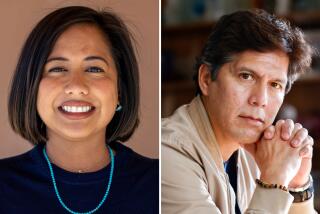Council OKs Plan That Places Woo in Latino District
- Share via
After a day spent unsuccessfully battling to fashion a compromise redistricting measure, the Los Angeles City Council tentatively approved a plan late Tuesday that would place Michael Woo, the council’s only Asian member, in a heavily Latino district.
The 10-5 vote approving a plan drafted by Councilman Richard Alatorre spelled at least temporary defeat for competing plans drawn by Woo and council President Pat Russell. Both lost on 9-6 votes.
The Alatorre plan was the first of the three to be drafted--all within the last two weeks--and benefited from the allegiance of council members who promised their votes to Alatorre before the other plans were announced.
More Tests Ahead
Despite the tentative approval, the Alatorre plan still faces a fight, along with a week of council lobbying, before it returns for final consideration. Both Woo and Russell said they will oppose final approval of the Alatorre plan, charging that it would cause a dangerous split between the Asian and Latino communities.
“We are just in the early chapters of what will be a long fight--whether it is a fight here in City Hall, whether it’s a fight in the court, or a fight elsewhere,” Woo said.
“This is a city for all of the people of Los Angeles. . . . This is not a city which will tolerate a racially divisive reapportionment plan which pits Asians against the Hispanics,” he declared.
Councilman Robert Farrell, for one, indicated that his vote for the plan Tuesday could be reversed by next week. “My vote on the Alatorre plan is a vote today because . . . there is a sense among council members to do something today,” he said.
Another potential stumbling block is Mayor Tom Bradley, to whom the redistricting plan will be sent for approval once the council takes final action.
Russell, a strong Bradley ally, said Tuesday night that there is “a good possibility” that Bradley would reject the Alatorre plan. Ten council votes would be needed to override a mayoral veto. Bradley has declined to say which plan he favors.
The vote climaxed a day of negotiating that brought to a head two weeks of open dissent and back-room lobbying among council members seeking to hold on to the districts in which they won election.
Earlier, with the council set to take its first formal redistricting vote, council members huddled over maps in the packed council chamber, seeking to figure out which of the three plans would give them the best deal.
Initially, none of the plans could summon the needed eight votes, so the council retreated to formal secret sessions and smaller negotiating meetings, trying to come up with a compromise plan.
Among the public, interest likewise ran high. The pending vote drew the comments of community groups ranging from the Communist Party of Los Angeles County to the Screen Actors Guild, whose president, Patty Duke, sent Bradley a letter urging that the Hollywood area remain in Woo’s district.
Response to U.S. Suit
The council agreed to redraw its district boundaries after the Justice Department filed suit against the city, claiming that the council’s 1982 redistricting plan had violated the Voting Rights Act by diluting the strength of Latino voters. Rather than allow the federal court judge hearing the case to draw the boundaries, the council set out to create a second Latino-dominated district itself.
The council is scheduled to submit a redistricting plan to federal court by July 31.
The Alatorre plan, which places Woo in a 65% Latino district, drew the immediate fire of Woo, Asian groups and Hollywood-area residents when it was made public two weeks ago.
Days later, Woo retaliated by releasing his own plan, which kept him in Hollywood and moved John Ferraro from his Wilshire District power base into a Latino-dominated district.
The third plan, officially unveiled by Russell before the council session Tuesday, would have collapsed Woo’s Hollywood base into Ferraro’s 4th district, setting up a race between the two incumbents in the 1987 municipal elections.
Until Tuesday night, the three district plan authors were unsuccessful in rounding up sufficient support from their council colleagues.
Role for the Voters
Russell said of her draft, “This plan avoids the destructive conflict we have seen in this city in past days between two minorities and some of the community and basically what it does is leave the decision to the voters.”
Alatorre called the Russell plan a “politically expedient” measure that took a course that he deliberately avoided.
“We have a plan that I think the city of Los Angeles can be proud of,” he said of his own plan.
Woo exhorted the council members to keep in mind the ethnic make-up of the city.
“Los Angeles is not a white city, Los Angeles is not a black city, Los Angeles is not dominated by any one particular group but rather increasingly is representative of all the different kinds of people on this planet,” he said.
“We need to make sure that a plan we approve reflects that kind of reality.”
Job for a Computer
Before the vote Tuesday, Councilman Joel Wachs suggested that the council give up its attempt to draw the district lines and let the federal court, or a computer, do it instead.
“As long as this council is going to be doing its own (boundaries) only the people who are totally protected ones are getting up and saying the other guy should jump off the plank,” Wachs said.
“As long as we do it on our own, we’re going to look out after our own interests and there isn’t a single one here who won’t and they’re lying if they say they will . . . Either let a court do it or a computer so that we get our own personal interests out of it.”
Councilman Marvin Braude, calling the process “really painful and demeaning,” had suggested that the council take another look at increasing its membership--to 17 or more--as a way of fulfilling the federal demand for more Latino seats.
Touch of Sarcasm
At that, Alatorre sarcastically offered commentary to consultants and reporters gathered near him in the chamber.
“I think we should just continue to introduce plans,” he said. “It’ll be a cold day in hell when everyone is happy.”
Ultimately, after the council dropped its efforts to negotiate a compromise, Alatorre found the votes, depending largely on the backing of the three black council members--Dave Cunningham, Gilbert Lindsay and Farrell--and San Fernando Valley representatives Howard Finn, Ernani Bernardi and Hal Bernson. The districts of all six were protected in the Alatorre plan. Also voting for the plan were Joel Wachs, Joan Milke Flores and Ferraro. Voting against it were Russell, Marvin Braude, Joy Picus, Zev Yaroslavsky and Woo.
Alatorre also won approval of amendments that guaranteed his plan the backing of the Mexican American Legal Defense and Educational Fund, one of the intervenors in the federal lawsuit. The amendments call on the city to develop a program to promote voter registration and to encourage naturalization of immigrants.
The NAACP, however, another of the lawsuit intervenors, remains opposed to the Alatorre plan, saying that it does not adequately insure equal voting rights for black citizens.
More to Read
Sign up for Essential California
The most important California stories and recommendations in your inbox every morning.
You may occasionally receive promotional content from the Los Angeles Times.












